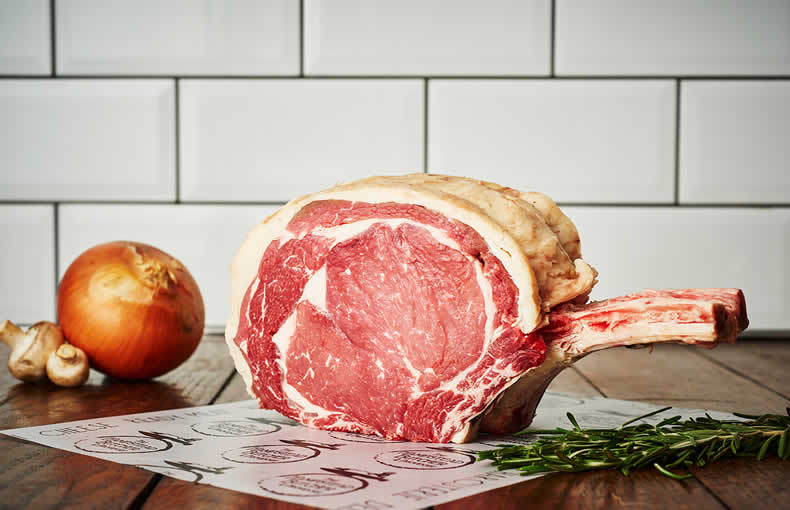
All of our beef is British. Each week we source top grade British Beef for our customers from our suppliers at London’s Smithfield Market and from independent farms in Norfolk, including a variety of English free-range, Scotch and other grass-fed varieties. We stock Aberdeen Angus X, a traditional British breed whose genes have remained unchanged for centuries. Native breeds such as this are hardy, often smaller in size and thrive in the UK climate. They are pasture-grazed, which is better for the environment, and for you as native beef is lower in saturated fat and higher In Omega 3 fatty acids and vitamin B and E than beef reared on cereal.
The traditional cut for roasting is Topside/Silverside. Taken from the hindquarter, the Topside is a lean and tender cut of meat. Both cuts are rolled and left with a sheet of fat around them to stop them drying out. Sirloin is also taken from the hindquarters, producing another cut of tender meat ideal for roasting.
The Rib of Beef is marbled with fat and makes for a juicy flavoursome roast joint. The bone can be left in or removed.
Shin and Brisket are both great cuts for slow-cooking. The shin is usually bought in medallions with the bone in or out and is ideal for stews, casseroles and braised dishes. Brisket is taken from the belly and produces a lovely tender, melt in the mouth meat when slow or pot roasted. Then there is the Chuck and Blade taken from the fore ribs. Usually sliced and diced for stewing.
Like the joint, the Rib Eye steak is taken from the fore ribs and has a little more fat for a very juicy and flavoursome steak. The T-bone is cut across the bone of the Sirloin and is both tender and tasty. Fillet Steak is the most lean and tender of all steak cuts and lends itself to being cooked quickly and rare.
Our beef is aged to develop flavour and to begin the natural tenderising process.
Our larger beef steaks and prime joints: T-Bone, Cote de Boeuf and Rolled Rib are dry-aged. Dry-aged meat may not look as pretty as freshly slaughtered meat, but there is good reason for that and it's what you should be looking for, not avoiding. After slaughter, the breakdown of oxygen in the blood produces lactic acid and it is this, which tenderises meat, adding flavour in the process. If an animal is stressed at the time of slaughter, then the oxygen in the blood is used by the muscles beforehand and lactic acid is not formed in the same quantities. It takes time for lactic acid to tenderise meat and indeed for gradual water loss to further concentrate the flavour.
Commercial restraints on supermarkets mean they simply do not age their meat for long enough - it is on the shelves as quickly as possible after slaughter. This results in the meat being tough and tasteless in comparison to meat that has been properly aged.
Sign up today for the latest news and special offers from the Hampstead Butcher & Providore.